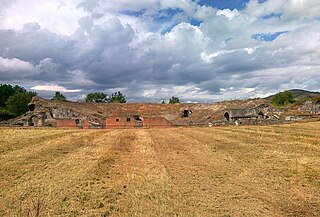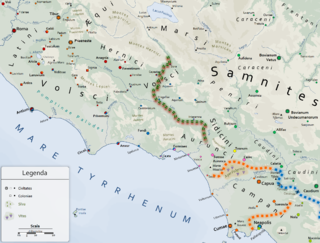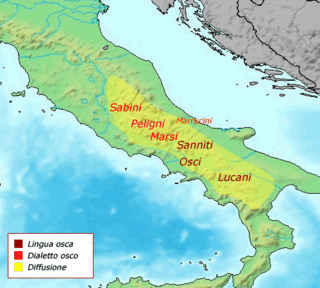
The Aurunci were an Italic tribe that lived in southern Italy from around the 1st millennium BC. They were eventually defeated by Rome and subsumed into the Roman Republic during the second half of the 4th century BC. [1]

The Aurunci were an Italic tribe that lived in southern Italy from around the 1st millennium BC. They were eventually defeated by Rome and subsumed into the Roman Republic during the second half of the 4th century BC. [1]
Aurunci is the name given by Roman writers to an ancient race or nation of Italy. It appears that "Aurunci" was the appellation the Romans gave to the people called "Ausones" by the Greeks. One form might be derived from the other by rhotacism (corruption of sound "s" in "r") [2] (Ausoni > Auroni > Auronici > Aurunci). [3]
The identity of the two is distinctly asserted by Servius, [4] and clearly implied by Cassius Dio, [5] where he says that the name of Ausonia was properly applied only to the land of the Auruncans, between the Volscians and the Campanians. In like manner, Festus makes the mythical hero Auson the founder of the city of Aurunea. [6] [7] Servius terms the Aurunci one of the most ancient nations of Italy. [8] They appear to have been much more powerful and widely spread at an early period than we subsequently find them, but it does not appear that the name was ever employed by the Romans in the vague and extended sense in which "Ausones" was used by the Greeks. [3]
At a later period, in the fourth century BC, the two names of Aurunci and Ausones had assumed a distinct signification, and came to be applied to two petty nations, evidently mere subdivisions of the same great race, both dwelling on the frontiers of Latium and Campania; the Ausones on the west of the Liris, extending from there to the mountains of the Volscians; the Auruncans, on the other hand, being confined to the detached group of volcanic mountains now called Monte Santa Croce , or Rocca Monfina , on the left bank of the Liris, together with the hills that slope from there towards the sea. Their ancient stronghold or metropolis, Aurunca was situated near the summit of the mountain, while Suessa, which they subsequently made their capital, was on its south-western slope, commanding the fertile plains from there to the sea. On the east and south they bordered closely on the Sidicini of Teanum and the people of Cales, who, according to Livy, [9] were also of Ausonian race, but were politically distinct from the Auruncans. Virgil evidently regards these hills as the original abode of the Auruncan, [10] and speaks of them as merely a petty people.
In contrast, in 495 BC, Dionysius of Halicarnassus refers to them as being a warlike people of great strength and fierceness, who occupied the fairest plains of Campania; so that it seems certain the name is here used as including the people to whom the name of Ausones (in its more limited sense) is afterwards applied. [3]
The first occasion in which they appear in Roman history exhibits them as a warlike and powerful nation who had extended their conquests to the borders of Latium. [3]
Livy tells us that in 503 and 502 BC, the Latin cities of Cora and Pometia revolted and allied themselves with the Aurunci. These powerful neighbours supported them with a large army against the infant republic; however, Rome ultimately prevailed. [11] [12] A few years later, in 495 BC, at around the time of a Volscian attack upon Rome, the Aurunci took up arms against Rome in support of the Volscian cause, and advanced with their army as far as Aricia, where they were defeated by the Roman consul Publius Servilius Priscus Structus. [13]
From this time, the name of the Aurunci does not again occur until 344 BC, when it is evident that Livy is speaking only of the people who inhabited the mountain of Rocca Monfina, who were defeated and reduced to submission without difficulty. [14] A few years later (337 BC), they were compelled by the attacks of their neighbours, the Sidicini, to apply to Rome for aid, and meanwhile abandoned their stronghold on the mountain and established themselves in their new city of Suessa. [15]
No mention of their name is found in the subsequent Roman wars in this part of Italy. In 313 BC, a Roman colony was established at Suessa; [16] their national existence must have been thenceforth at an end. Their territory was subsequently included in Campania. [3] [17]
The Aurunci mountains and the modern town of Sessa Aurunca bears the Aurunci's name.

The Osci were an Italic people of Campania and Latium adiectum before and during Roman times. They spoke the Oscan language, also spoken by the Samnites of Southern Italy. Although the language of the Samnites was called Oscan, the Samnites were never referred to as Osci, nor were the Osci called Samnites.

The First, Second, and Third Samnite Wars were fought between the Roman Republic and the Samnites, who lived on a stretch of the Apennine Mountains south of Rome and north of the Lucanian tribe.
Ausona was a 4th-century BC city in the central Italian region of Latium. It was one of the three cities possessed by the tribe of the Ausones and its name seems to imply that it was their chief city or metropolis. It is only once mentioned in history: during the Second Samnite War, when—the Ausones having revolted against the Romans—all three of their cities were betrayed into the hands of the Roman consuls, and their inhabitants put to the sword without mercy. No subsequent notice is found of Ausona; but it is supposed to have been situated on the banks of the little river still called Ausente, which flows into the Liris near its mouth. The plain below the modern village of Le Fratte, near the sources of this little stream, is still known as the Piano dell'Ausente; and some remains of a Roman town have been discovered there.

The Liri is one of the principal rivers of central Italy, flowing into the Tyrrhenian Sea a little below Minturno under the name Garigliano.
Monte Massico is a mountain situated in the Italian Province of Caserta (Campania) between the rivers Volturno and Garigliano.

The Battle of Mount Gaurus, 343 BC, was the first battle of the First Samnite War and also the first battle fought between the Roman Republic and the Samnites. The battle is described by the Roman historian Livy as part of Book Seven of his history of Rome, Ab Urbe Condita Libri, where he narrates how the Roman consul Marcus Valerius Corvus won a hard-fought battle against the Samnites at Mount Gaurus, near Cumae, in Campania. Modern historians however believe that most, if not all, of the detail in Livy's description has been invented by him or his sources.

Teano is a town and comune in the province of Caserta, Campania, southern Italy, 30 kilometres (19 mi) northwest of Caserta on the main line to Rome from Naples. It stands at the southeast foot of an extinct volcano, Rocca Monfina. Its St. Clement's cathedral is the see of the Roman Catholic Diocese of Teano-Calvi, which started as the Diocese of Teano circa AD 300.

Sessa Aurunca is a town and comune in the province of Caserta, Campania, southern Italy. It is located on the south west slope of the extinct volcano of Roccamonfina, 40 kilometres (25 mi) by rail west north west of Caserta and 30 kilometres (19 mi) east of Formia.

The Battle of Lautulae was a battle fought in 315 BC during the Second Samnite War, opposing the Roman Republic and the Samnites, who defeated the Romans.

Cales was an ancient city of Campania, in today's comune of Calvi Risorta in southern Italy, belonging originally to the Aurunci/Ausoni, on the Via Latina.

Latium adiectum or Latium Novum was a region of Roman Italy between Monte Circeo and the river Garigliano, south of and immediately adjacent to Old Latium, hence its name of attached Latium.

The (Second) Latin War was a conflict between the Roman Republic and its neighbors, the Latin peoples of ancient Italy. It ended in the dissolution of the Latin League and incorporation of its territory into the Roman sphere of influence, with the Latins gaining partial rights and varying levels of citizenship.

"Ausones", the original name and the extant Greek form for the Latin "Aurunci", was a name applied by Greek writers to describe various Italic peoples inhabiting the southern and central regions of Italy. The term was used, specifically, to denote the particular tribe which Livy called the Aurunci, but later it was applied to all Italians, and Ausonia became a poetic term, in Greek and Latin, for Italy itself.

Ausonia is a town and comune in southern Lazio, central Italy. It takes its name from the Ausones/Aurunci, whose ancient town Ausona, located nearby, was destroyed by the Romans in 314 BC. In the Middle Ages it was known as Fratte.
Sinuessa was a city of Latium, in the more extended sense of the name, situated on the Tyrrhenian Sea, about 10 km north of the mouth of the Volturno River. It was on the line of the Via Appia, and was the last place where that great highroad touched on the sea-coast. The ruins of the city are located in the modern-day municipality of Sessa Aurunca, Campania, Italy.
Suessa Pometia was an ancient city of Latium, which had ceased to exist in historical times. Although the modern city of Pomezia is named after it, the exact location of the ancient city is unknown.

The Campanians were an ancient Italic tribe, part of the Osci nation, speaking an Oscan language.
The ancient city of Aurunca was the capital or metropolis of the little mountain tribe of the Aurunci, was situated on one of the summits of the volcanic group of mountains, which rise above the plains of Campania, near Suessa and Teanum.
Lucius Papirius Crassus was a Roman politician. He was appointed dictator in 340 BC, and consul in 336 BC and 330 BC. Lucius Papirius was from the Papiria gens (family) in Rome.
The Sidicini were one of the Italic peoples of ancient Italy. Their territory extended northward from their capital, Teanum Sidicinum, along the valley of the Liri river up to Fregellae, covering around 3,000 square kilometres in total. They were neighbors of the Samnites and Campanians, and allies of the Ausones and Aurunci. Their language was a part of the Osco-Umbrian linguistic family.
"In multis verbis, in quo antiqui dicebant s, postea dicunt r... foedesum foederum, plusima plurima, meliosem meliorem, asenam arenam."See Latin: Rhotacism— Varr. De lingua Latina, VII, 26.